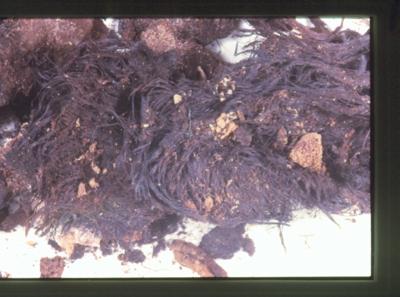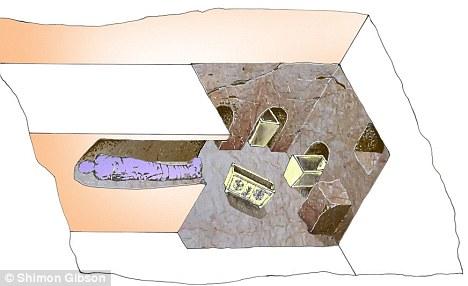James Tabor
http://www.biblicalarchaeology.org/daily/ancient-cultures/ancient-israel/the-only-ancient-jewish-hair-ever-found/
The braided hair of a Jewish woman was found at Masada but until recently no example of preserved hair from a Jewish male had ever been found from the late 2nd Temple period. This discovery is one of the many fascinating, but less publicized finds of the 1st century “Tomb of the Shroud,” discovered in the summer of 2000 just outside the Old City of Jerusalem. The secrets this tomb continues to yield are many, including recent correlations with the DNA test results from the Talpiot Jesus tomb.

Many of the most interesting archaeological discoveries are accidental. There seems to be an unwritten axiom, those who seek never find, and those who find were not seeking. I have participated in over 20 seasons of excavation at five different sites over the past 25 years and I can’t count the times when suddenly, “out of the blue,” one of our students, volunteers, or a staff member, suddenly findssomething significant–totally unexpected! Such was the case with the 15 line ostracon at Qumran in 1996, the engraved 1st century menorah we found at Sepphoris in 1999, or the mysteriously inscribed stone vessel at Mt Zion in 2009.
I have to say that until our recent discoveries in the Talpiot “Patio” tomb, the most exciting find in which I have been involved had to be the wholly accidental late night discovery of the freshly robbed tomb in Akeldama, in the Valley of Hinnom, just south of Jerusalem. It was June 14, 2000. Shimon Gibson and I were hiking just south of the Old City with five of our students, showing them some of the abandoned 1st century tombs of that area. We had been in Israel for two weeks excavating at the Suba “John the Baptist” cave. We suddenly and unexpectedly came upon a freshly robbed entrance to one of the many 1st century tombs that are in that area–many of them still sealed. We could see broken ossuaries, scattered bones, and displaced soil where the invaders had removed the blocking stone to the tomb and tunneled inside.

The rest is now history. This amazing three-level tomb, cut into bedrock, contained in a lower niche orkokh, the partially preserved skeletal remains of a male with a badly deteriorated cloth burial shroud still visible! We could hardly believe our eyes. Joe Zias, whom we told about the discovery the next day, was so sure the cloth had to be a later reburial swore that he would heat his “hat”–a plastic cyler’s hat at that–if our cloth turned out to be ancient.
I had the cloth dated at the University of Arizona C-14 lab. Douglas Donahue, the same scholar who tested the Shroud of Turin, dated our cloth–it came out 1st century CE, and made headlines around the world, see here and here. Although 1st century cloth has been found at Masada and in caves in the Judean Desert, nothing of this sort had ever been found in Jerusalem. Apparently that niche, sealed with a blocking stone, had a geological fissure that kept water from seeping in and rotting the material.
The tomb had any number of interesting features. DNA studies were done on all the individuals represented in the tomb–the first time, so far as we know, that this had even been done in an ancient Jerusalem tomb of this period. Textile analysis was done on the cloth–it turned out to be a layered mixture of linen and wool. Perhaps the most surprising find was that our shrouded individual, a male, had Hanson’s disease–leprosy–the 1st documented case from the ancient world in this region, see my post on this here. Gibson, Zissu, and I published our preliminary results later that same year[1] and in 2009 a complete scientific study appeared in the on-line journal PLoS One, available for download here.
One of the more fascinating finds in this tomb, one that has not received much attention, was the preservation of a sample of Jewish male hair. The hair was lice-free, and trimmed or cut evenly, probably indicating that the family buried in this tomb practiced good hygiene and grooming. The length of the hair was medium to short, averaging 3-4 inches. The color was reddish.
The Tomb of the Shroud continues to offer more surprises. We recently noticed that the mitDNA tests of two of the individuals in this tomb match the polymorphisms of two individuals in the Jesus family tomb–namely skeletal materials taken from both the Yeshua and the Mariamene ossuaries. What the implications of this might be, and whether there is any possible relationship between these two families, remains to be explored. For one particularly tantalizing possibility, see Shimon Gibson’s speculations regarding the James ossuary being stolen from the Akeldama “tomb of the Shroud.”[2]
Notes
1. “Jerusalem—Ben Hinnom Valley,” with B.Zissu, S.Gibson, Hadashot Arkheologiyot (Jerusalem: Israel Exploration Society, 2000), Vol.III, pp. 70*-72*, Figs.138-139.
2. Shimon Gibson, “A Lost Cause: A Response from Shimon Gibson on the James Ossuary Inscription” Biblical Archaeology Review 30:6 (2004) 55-58.